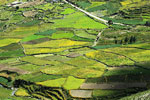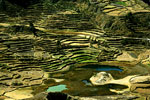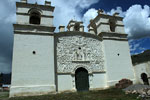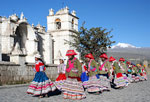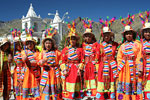Colca Valley
Colca Valley (Valle del Colca) is the most popular excursion from Arequipa. Valley formed by the Colca river in which side banks exists a great beauty scene, hot springs, and enormous cultural attractiveness where you will have an encounter with the descendants of the Collaguas. Special place to appreciate a Living Culture.
In Colca area there are hotels, from economic rates located in the towns, luxury hotels and lodges are located in the countryside. The minimum recommended to visit is 2 days, combined with Colca Canyon.
Chivay Town, the normally entrance to Colca Valley, is located at 180 Km. (111.8 miles) north of Arequipa city, Colca Valley was used to be called the Valley of the Collaguas which is formed by the river of the same name. Collaguas river is formed by two rivers called Majes and Camaná.
The Collaguas were a pre-Inca tribe that lived in this area. Accomplished artists in textiles and stone carvings, during the colonial period, they worked as bricklayers and "hayllis" music composers. The current residents of this valley are heirs of the ancient collaguas crafts.
The valley is enclosed before the Colca Canyon and runs from east to west. The cold waters from the Colca River are coming from the top of the mountains and on the side banks of the river is a beautiful scenery and lots of cultural activity.
We can visit the carved rocks of Sumbay and Toro Muerto, where residents pre-dating the Collaguas left their mark in their drawings of dancers with strange headdresses, animals, condors and other figures that still mystify us today.
Pre-Incas and Incas inhabitants of this valley used deposits known as "collcas" to store grain. The valley took its name as a result of the great number of these collcas. Lots of these collcas can be visited and one of the most important to visit is the Pumunuta collca, which is located in a frozen cave.
Influenced by colonialization and religion, the ethnic architecture make the villages throughout the Colca Valley rich in beauty and charm. There are sixteen villages in this zone made up of descendents of the Collaguas and Cabanas tribes, inheritors of rich cultural traditions. The towns of Chivay and Cabanaconde are the most visited by tourists.
The following towns are recommended to visit: (left shore river) Chivay, Yanque, Achoma, Maca, Pinchollo and Cabanoconde, (right shore river) Coporaque, Ichupampa, Lari and Madrigal.
In this whole region the beauty of the landscape is formed by "andenes" (series of steps on the hills used for sowing, technique used from the times of the Incas, some with artificial irrigation and others for effects of the rains.)
Here you can also appreciate volcanos and snowy mountains such as Ampato 6,288 meters above sea level (19,054 feet), Sabancaya 5,976 meters above sea level (17,563 feet), Hualca Hualca 6,025 meters above sea level (18,257 feet), Coropuna 6,425 meters above sea level (21,079 feet), Solimana 6,117 meters above sea level (20,068 feet), and the , etc.
The Colca Valley has become a paradise for adventure travelers since it is ideal for river running, trekking and mountaing biking as well as other sports.
The Colca valley forms part of the South American tectonic plate and contains the active volcano Sabancaya, located on the volcanic mountain Hualca Hualca. This valley possesses a great diversity of flora and fauna. Among the most representative species are the condor, the kestrel, the peregrine falcon, and the Andean tinamou.
On October 13th, 1995, John Reinhard and Antonio Chavez from the Catholic University of Arequipa discovered, in the peak of the Ampato Mountain, three icy Inca mummies very well conserved because of the freezing temperature, they thought it were Inca's sacrifices. The principal mummy was a maid, called "Juanita", but they changed the name into "La Dama de Ampato", you can visit it now at the Santury Museum in Arequipa City. (See the history in National Geographic)
To visit this area, you can go by car from Arequipa with a tourist guide; the visit will pass through the National Reserve Salinas and Aguada Blanca and the Pampa Cañahuas.
The Colca Valley is a great scenario to birdwatching for Andean species
It is advised to make your visit to this area not shorter then two days. You can find lodgings and hotels in this area. Daily tours from Arequipa and Puno.
 Hotels & Lodges in Colca Valley
Hotels & Lodges in Colca Valley
 Bus Service Colca Valley / Puno Lake Titicaca
Bus Service Colca Valley / Puno Lake Titicaca
COLCA VALLEY PHOTO GALLERY
COLCA VALLEY MAP
 AREQUIPA PHOTO GALLERY
AREQUIPA PHOTO GALLERY
- Casa del Moral
- Children of Colca
- Colca Canyon Landscapes
- Colca Valley Landscapes
- Colca Valley Landscapes 2
- Colonial Large Houses
- La Catedral (The Cathedral)
- La Compañía - Church
- La Compañía - Cloister
- La Mansión del Fundador

